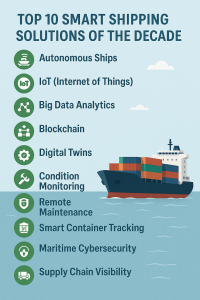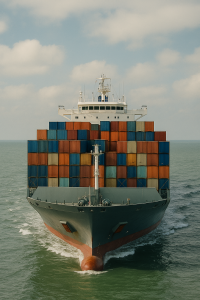Discover the top 10 smart shipping solutions of the decade that are transforming the maritime industry. Learn how digitalization, automation, and AI are driving safer, greener, and more efficient voyages.
Why Smart Shipping Solutions Matter in Modern Maritime Operations
The maritime industry is undergoing a paradigm shift. As global trade continues to expand, shipowners, operators, and regulators are seeking ways to enhance operational efficiency, safety, and sustainability. Enter smart shipping—the integration of digital technologies such as artificial intelligence (AI), Internet of Things (IoT), automation, and data analytics to transform how ships are built, operated, and maintained.
Far from being a futuristic concept, smart shipping is already here—and it’s scaling rapidly. According to the International Chamber of Shipping (ICS), more than 90% of shipping companies have adopted at least one digital solution since 2020. Meanwhile, the IMO’s e-navigation strategy is accelerating the shift toward data-driven decision-making, real-time vessel monitoring, and autonomous operations.
This article explores the top 10 smart shipping solutions of the decade, showcasing how innovation is reshaping everything from voyage planning to predictive maintenance.
1. Autonomous Ship Navigation Systems
Autonomous ship systems use advanced sensors, AI, and decision-making algorithms to navigate without direct human control—or with limited remote assistance.
Key Capabilities:
-
Obstacle detection and avoidance
-
Route optimization
-
Collision risk management
Case Study: Yara Birkeland, the world’s first fully autonomous and electric container ship, successfully completed trial voyages in Norwegian waters with zero crew on board.
IMO Outlook: The Maritime Autonomous Surface Ships (MASS) regulatory scoping exercise is paving the way for global legal frameworks.
2. AI-Powered Voyage Optimization
Artificial intelligence systems analyze weather, sea conditions, fuel pricing, and port congestion to suggest the most cost-effective and environmentally friendly routes.
Benefits:
-
Up to 15% fuel savings
-
Reduced emissions
-
Enhanced ETA accuracy
Platforms to Watch: Wärtsilä’s Navi-Planner, ABB’s Ability Marine Advisory, and StormGeo’s s-Insight are widely used in global fleets.
3. Digital Twin Technology
A digital twin is a virtual replica of a ship that continuously syncs with real-time operational data. It enables:
-
Predictive maintenance
-
Structural stress monitoring
-
Performance benchmarking
Example: DNV’s digital twin solutions allow continuous class monitoring, reducing physical inspections and downtime.
Analogy: Think of it as a live, digital health chart of the vessel—always up-to-date, always alert.
4. IoT-Based Engine Performance Monitoring
Internet of Things (IoT) devices collect real-time data from:
-
Main engines
-
Auxiliary machinery
-
Fuel injection systems
-
Exhaust scrubbers
This data is transmitted to shore-based centers for monitoring efficiency, emissions, and maintenance needs.
Real-World Benefit: Early detection of anomalies helps prevent breakdowns, reduce fuel use, and improve EEXI and CII compliance.
5. Blockchain for Maritime Documentation
Blockchain provides tamper-proof digital records for shipping documentation, including:
-
Electronic bills of lading (eB/L)
-
Crew certificates
-
Maintenance logs
Pilot Success: TradeLens, developed by IBM and Maersk, successfully processed millions of container events before being retired in 2023. Its legacy now informs similar platforms like GSBN.
6. Smart Port Integration and Port Call Optimization
Smart ships are only half the solution. When paired with smart port systems, operators can:
-
Coordinate berth availability
-
Minimize idle anchorage time
-
Streamline customs and documentation
Example: Hamburg Port uses a smart logistics platform that coordinates ETA updates with vessel sensors, reducing port congestion and GHG emissions.
IMO’s Just-In-Time Arrival Guide supports such integrations under MEPC.1/Circ.897.
7. Cybersecurity and Threat Detection Systems
With greater connectivity comes greater risk. Smart ships require robust cybersecurity frameworks, including:
-
Intrusion detection systems
-
Endpoint protection
-
Role-based access control
-
USB port lockdowns
Mandatory Compliance: Since 2021, cyber risk management must be part of Safety Management Systems (SMS) under the ISM Code.
Training: Platforms like the ICS Cyber Security Workbook and BIMCO’s guidelines help crews stay vigilant.
8. Remote Surveys and Inspections
Remote inspection tools—like drones, ROVs (Remotely Operated Vehicles), and 360° cameras—allow class societies to assess vessel conditions without physical boarding.
Benefits:
-
Reduced surveyor travel
-
Faster inspections
-
Enhanced crew safety during inspections
Used By: ABS, Lloyd’s Register, DNV, and Bureau Veritas all offer certified remote surveys.
9. Emission Monitoring and Compliance Software
Smart emission monitoring tools ensure compliance with:
-
IMO 2020 sulfur cap
-
EEXI (Energy Efficiency Existing Ship Index)
-
CII (Carbon Intensity Indicator)
How It Works:
-
Sensors collect CO₂, NOx, SOx, and particulate data
-
Data is logged and reported to regulatory databases
-
AI adjusts engine loads for optimal emissions performance
Integration Example: Eniram’s energy management software has helped fleets reduce CO₂ emissions by over 30% per vessel annually.
10. Cloud-Based Fleet Management Platforms
Fleet-wide dashboards integrate:
-
Fuel consumption
-
Maintenance schedules
-
Weather routing
-
Crew management
Platforms Include:
-
NavFleet by Kongsberg
-
ShipManager by DNV
-
OrbitMI
These solutions enable centralized control over global operations, ensuring fleet performance optimization and cost control.
Case Study: Maersk’s Smart Fleet Operations
Maersk has invested heavily in digital integration, leveraging AI routing, blockchain logistics, and smart bunkering solutions. Their use of real-time performance analytics has contributed to:
- 15% improved fuel economy
- Faster turnaround at ports
- Reduced emissions fleetwide
Their digital roadmap exemplifies how large fleets can scale smart shipping for environmental and commercial gain.
FAQ: Smart Shipping Solutions
Q1: Are smart shipping systems affordable for small operators?
A: Many solutions are scalable. Cloud-based dashboards, fuel management tools, and e-learning platforms offer cost-effective entry points for smaller fleets.
Q2: What regulations support smart shipping adoption?
A: The IMO supports e-navigation, MASS frameworks, cyber risk management, and just-in-time shipping. Regional bodies (e.g., EMSA) also incentivize digitalization.
Q3: Can these systems be retrofitted into older ships?
A: Yes. Most smart solutions are designed to integrate with existing machinery, especially monitoring and cloud-based platforms.
Q4: How is crew training adapting to smart shipping?
A: Training now includes simulation-based learning, cybersecurity drills, and digital familiarization, supported by IMO Model Courses and MET institutions.
Q5: What are the main risks in smart shipping?
A: Cybersecurity, system interoperability, and over-reliance on automation are key risks—but they are manageable with proper training and governance.
Conclusion
The decade’s top smart shipping solutions are not only transforming maritime logistics—they are redefining the role of the ship itself. In a world of digital twins, AI voyage planning, and blockchain verification, the modern vessel is as much a data platform as a transport unit. Adopting smart technologies is not about chasing trends—it’s about building a resilient, efficient, and sustainable maritime future. From major carriers to independent operators, the digital tide is rising—and those who navigate it skillfully will lead the fleet of tomorrow.
Call to Action: Stay ahead of the curve with tools, guides, and updates at our Smart Maritime Innovation Center.
References
-
International Maritime Organization. (2023). E-Navigation Strategy Implementation Plan. https://www.imo.org
-
ICS. (2022). Cyber Security Workbook for Onboard Ship Use. https://www.ics-shipping.org
-
DNV. (2023). Smart Ship Technology Insight. https://www.dnv.com
-
Wärtsilä. (2023). Digital Marine Ecosystem Solutions. https://www.wartsila.com
-
BIMCO. (2023). Guidelines on Cyber Security Onboard Ships (Version 4). https://www.bimco.org



